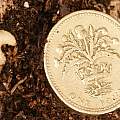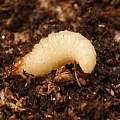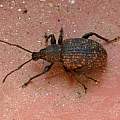As far as the gardener is concerned, the black vine weevil (Otiorhynchus sulcatus) exists solely to destroy beautiful plants.
In the warm part of the year it lives as a flightless, crawling beetle, biting notches out of the edges of leaves and laying eggs around the base of plants. The eggs turn in to grubs or larvae which spend the winter underground eating roots. It is this latter stage of the life cycle which does the damage.
Whilst in the open garden the larvae are usually not a problem perhaps nibbling a bit from one plant and moving to the next as well as being kept in check by predators, but confined to pots they eat all the roots of individual plants, one day the plant looks fine, the next it collapses and there are no roots left.
In the crawling phase vine weevil can be hunted down hiding under leaves, their defence strategy is to drop to the ground and play dead, making them easy prey for the gardeners boot, but a considerable force is required to crush them.
Larvae can be controlled by watering on suitable nematodes in autumn or applying an insecticide drench to the compost. They do not like drowning, standing plants in water will bring them to the surface. They are capable of moving from one plant pot to another when they have exhausted the roots.
A wide range of plants are attacked, ranging from trees like Taxus baccata to Primula, favourite geophytes are Cyclamen and Lilium. Vine weevil will eat their way into the bulbs of these species.
There are only female vine weevils, unfertilised eggs develop into larvae (parthenogenesis). In the spring the larvae complete the metamorphosis cycle, via a pupa stage, turning into adults.
Photographs by David Pilling.
Click here to see PBS list postings about vine weevil.


